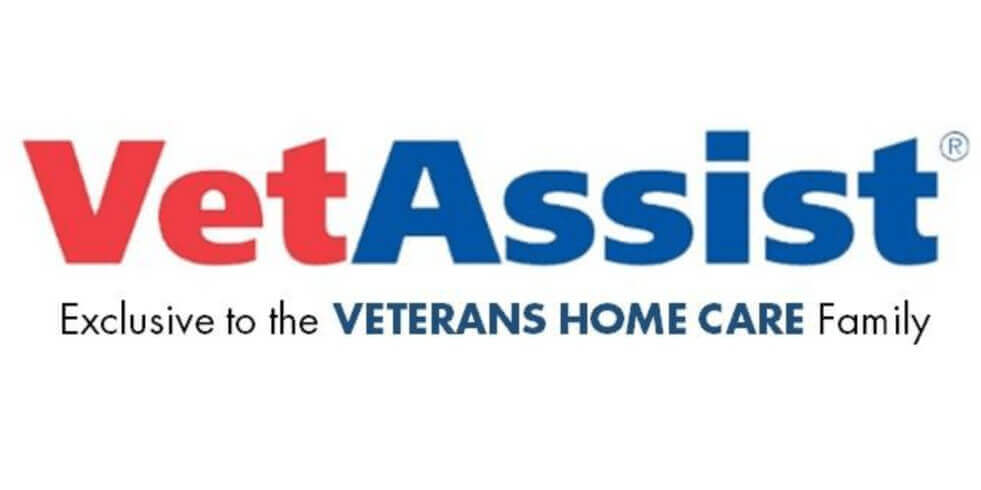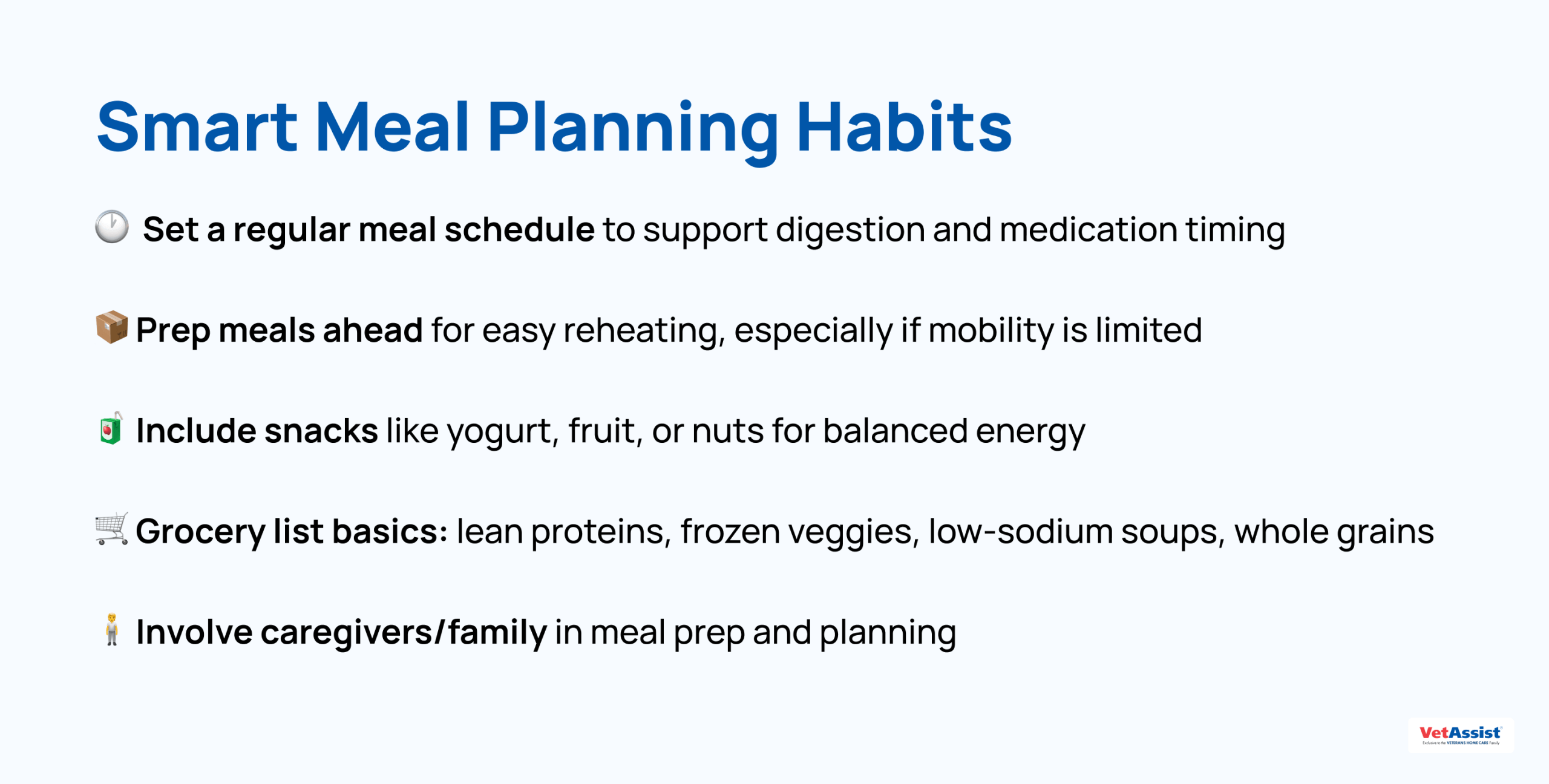Healthy Nutrition & Meal Planning for Seniors
Nutrition is an important foundation for good health, and as we age, healthy meals can greatly impact our day-to-day wellbeing. Our energy levels, blood sugar, aches and pains, and management of chronic conditions can be influenced by what we eat and drink.
The principles of nutrition for older adults should be considered by caregivers as they determine the best diet for seniors under their care. The following are some guidelines for how to meal plan for seniors at home, whether you are trying to meal prep for elderly parents or help a loved one find a more balanced diet to support their health as they age in place.
Nutrition and Aging
According to the National Institute on Aging and the USDA, there are some effective shortcuts to better meeting senior nutrition needs: cut down sodium, sugar, and saturated fat, add vitamins and protein, and stay hydrated. While reducing or eliminating sugary drinks, fried foods, and salty snacks benefit blood pressure and cholesterol, adding lean protein (such as beans, lentils, fish, and fat free dairy) helps build and maintain muscle mass as we age. Drinking more water helps the body digest food and better absorb its nutrients.
The USDA advises eating several servings each day of different vegetables and fruit, as well as maintaining a healthy weight through diet and exercise. (Their free MyPlate tool provides a guideline of calorie needs based on age, sex, height/weight, and daily activity level.) The NIA further advises increasing intake of vitamin B12 and a few key others through fortified foods (such as cereal) or supplements.
These tips are a start to building good meal plans for seniors, but before charging ahead with the best intentions, it is worth slowing down and considering some other realities:
- Our like and dislike of some foods change over time, and foods we might have loved in the past might be unappetizing now. In addition, medication can change the taste of some foods. Forcing a diet of unappealing foods is long-term ineffective in ensuring healthy, balanced nutrition. It is best to incorporate the senior’s current tastes in meal planning while staying within healthy parameters.
- Some foods may be uncomfortable to chew or swallow, and some may irritate the stomach in a way they never used to. Think about cooking methods that accommodate the senior’s comfort (pureéd soups and smoothies are versatile), and don’t force foods like tomatoes into the diet if they cause discomfort.
- Adding brand new foods to a diet comes with the risk that the senior has undiscovered allergies or food sensitivities. Add new foods slowly, in small quantities, and pay attention to any complaints of pain or adverse reactions. The senior can also get tested for food allergies.
- Your parent or loved one may have health conditions that should be taken into account when meal planning. Examples might be diabetes, osteoporosis, or past GI surgeries.
In all cases, when meal planning for elderly adults—especially those with chronic illness, prescription medications, or other medical needs—it is wise to consult a registered dietician with a gerontology specialty, or at least a geriatrician.
Meal Ideas for Seniors
There is a wide world of recipes online that make it easy to prepare meals for elderly adults. Within this wealth of recipes are meal plans for vegetarian, vegan, gluten-free, nut-free, or low FODMAP needs, as well as Mediterranean-inspired diets, low-carb diets, and many more variations. When searching for recipes, bear in mind the need to keep meals low in saturated fat, sodium, and sugar. Also consider what kitchen appliances and tools you’re comfortable using, as well as your budget and storage for ingredients.
A daily meal plan might look like:
- Breakfast: one serving of grains, one serving of protein, and one serving of fruit
- Mid-morning snack: one serving of grains and one serving of fruit
- Lunch: two servings of grains, two servings of protein, and two servings of vegetables
- Afternoon snack: one serving of protein and one serving of vegetables
- Dinner: two servings of grains, two servings of protein, and two servings of vegetables
In the bare-bones example above, you can think of the following “key”:
- Grains: bread, cereal/oats, rice, pasta, pearl barley, quinoa… (Whole grain options are better unless advised otherwise by a doctor.)
- Protein: low- or non-fat milk/cheese/yogurt (dairy or plant-based), raw nuts and nut butter, fish, legumes (beans, lentils, peas) and hummus, egg whites, tofu…
- Fruit: fresh or frozen berries, apple, banana, stone fruit, citrus fruit, melon…
- Vegetables: fresh or frozen broccoli, spinach, kale, peppers, carrots, tomatoes, Brussels sprouts, mushrooms, squash… (Choose these more often over starchy vegetables such as potatoes or corn.)
Note that sugar, syrups, sauces, oils, and dressings may be added in moderation to meals to enhance their flavor and fun—but also consider herbs, spices, vinegars, and nonfat condiments such as salsa and mustard.
Six Tips for Meal Prep Made Easy
Once you get started on your meal planning, there are a few additional tips you can remember to make healthy meal prep a sustainable habit for real impact on your loved one’s health and wellness.
1. Involve the senior in meal planning.
Taking input from your loved one increases the chance that they will enjoy and stick to their healthy meal plan. Do they love sandwiches, omelets, Italian food, or tacos? Use their existing preferences to build appealing meals.
2. Stay realistic.
Unless you have the time and interest, beware of buying tons of fresh produce that will require a lot of preparation for meals. Frozen vegetables, including bagged blends like stir fry mix, offer the same nutrition at a lower cost in both time and money. Frozen fruit is also a great addition to smoothies and baked or overnight oats.
3. Think ahead.
Batch cooking is a great way to save time and effort to keep the meal plan on track. Think sheet pan dinners where the leftovers can be repurposed as a salad or pasta dish, or soups that can be portioned and frozen to eat again in a few weeks. Meal plan a week or so at a time, and bring back frozen leftovers to give yourself a few nights off from cooking.
4. Check labels.
When buying pasta sauce, canned soup, cereal, yogurt, and more, always check nutrition labels to make sure it is as natural as possible (ingredients you can identify and pronounce) and low in sodium, sugar, and saturated fat.
5. Take stock of your tools.
If your loved one is actively involved in meal prep, check out kitchen gadgets for elderly users such as jar openers and rocker knives. Make sure the kitchen floor has non-slip mats and look out for other potential hazards, such as items too high up to reach. Large, loud timers are a good idea to prevent burned dinners or household accidents, or your loved one can rely on voice-activated devices for both reminders and a quick call for help.
6. Delegate to a professional.
Meal prep is one of many tasks that can be entrusted to a professional caregiver. If your loved one is aging in place and unable to prepare their own meals—and you are unable to cook for them yourself—a caregiver can offer the same care and attention to their nutritional needs. This is one of many services covered by the VA’s Aid and Attendance benefit, for those seniors who qualify.
Meal planning for senior nutrition can make a marked difference in your loved one’s quality of life. With a little time, effort, and creativity, seniors aging in place can experience better health through nutritious meals.
If your loved one needs home care, our VetAssist mission is to make home care easily and quickly accessible for those who qualify through the VA Pension with Aid and Attendance benefit. Veterans Home Care can help you determine whether you or your loved one will be eligible to receive the benefit, which can cover some or all of the cost of home care, and we make it easy to apply. Chat with us via our website, or call us at (888) 314-6075.

















